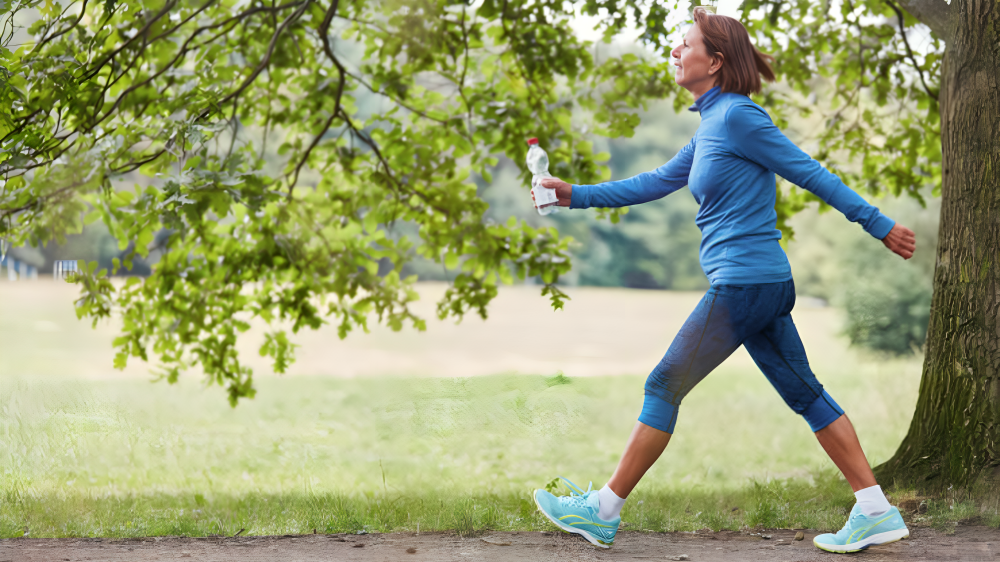
What is walking
Walking is something most of us do every day without giving it much thought. But did you know that this simple activity is actually one of the best forms of exercise out there? It’s low-impact, easy to start, and offers a long list of health benefits. Whether you’re looking to improve your fitness, reduce stress, or just get outside more, walking can be your go-to solution
How to do walking
Posture Is King
Maintain good posture to avoid injury and be more effective at walking.
Position yourself with your head held up, shoulders relaxed, and an upright torso.
Keep your eyes on the horizon and not on the floor.
Activate your inner muscles to stabilize your lumbar region.
Allow your arms to hang limply by your sides.
Foot Strike Pay attention to how you strike the ground.
Land with your heel first and roll through to toe off. Avoid stomping or taking too long of a step. You want your steps to feel fluid and natural.
A brisk walk will get your heart rate up appropriately for cardio health but at about 3-4 miles per hour.
You should be breathing a bit harder, but still be able to carry on a conversation.
If you are new to walking, start slowly and get gradually faster.
Walk for a Set Time, Not Just Distance
Instead of thinking of how far you walk, think of how long you walk. – Shoot for 30 minutes a day at least 5 days a week. – If that sounds too much, start with 10-15 minutes and build up from there.
Make It Enjoyable Walking doesn’t have to be boring. – Listen to your favorite music or podcast.
-New trails, parks, or neighborhoods..
-Walk with a friend or as part of a walking group for extra motivation.
Benefits of walking
Improves Heart Health
It is a good way of keeping the heart in shape: Walking reduces the risk of getting diseases associated with the heart through improving circulation and lowering blood pressure. It has been found out that walking for at least 30 minutes a day lowers your chances of heart problems to about 19%.
Supports Weight Loss
So, if you want to lose a few pounds, walking may be the best for you. It doesn’t burn as many calories as running, but it’s an excellent way to trim fat when combined with healthy eating. A brisk 30-minute walk can burn around 150 calories for a typical individual and his speed. These burnt calories do add up over time.
Improves Mental Health
Stressed, anxious, or feeling down? Walking is a natural mood booster. It raises the secretion of endorphins: the so-called “feel-good” hormones that would help lower the stress level and anxiety. Time spent outside is especially good, as proved by many studies. Spending time in nature leads to lesser tension, they said.
Walking encourages the toning of leg muscles and the strengthening of bones. It is a weight-bearing activity, meaning your bones and your muscles have to work to keep you vertical, which helps you avoid conditions like osteoporosis as you age. In addition, stronger muscles and bones reduce injury and falls.
Improves Sleep Quality
If you are having problems sleeping, some walking may be in order. It has the same effect as the daytime exercise: it facilitates falling asleep and improves the quality of the sleep. Just make sure to walk at least a few hours before bed time to allow your body to unwind.
Increases Creativity
Need some inspiration? Take a walk! Walking helps you clear your mind and allows free flow of thoughts. Research has revealed that one is more likely to come up with creative solutions for problems while walking than sitting. So the next time you get stuck on a project or need a mental break, the best thing is a short walk.
It’s Here Weighted Neck Curl How to Do It and what are the Benefits
FAQs
1. How many steps should I strive for daily?
Most of the experts always say to shoot for 10,000 steps a day. But if you are a complete beginner, then focus on a time duration like 30 minutes a day and then proceed with the step count.
2. Is walking equivalent to running?
Both walking and running have excellent merits for health, but running burns more calories in a lesser time, while walking is very gentle on your joints, and it also offers excellent health merits.
3. Can walking lessen back pain?
Yes! Walking can improve posture, strengthen muscles, and promote flexibility, all contributing factors to lessening back pain over time.
4. Do I stretch before or after walking?
It’s better to do some gentle stretching after your walk when your muscles will be warm. Stretching beforehand might cause stiffness or soreness.
Walking is perhaps the easiest and most accessible way of keeping fit. Whether it’s for a healthy heart, weight loss, or mental clarity, putting it into your daily life really makes a lot of difference. So take up your walking shoes, get out, and go about finding the rewards for yourself!

